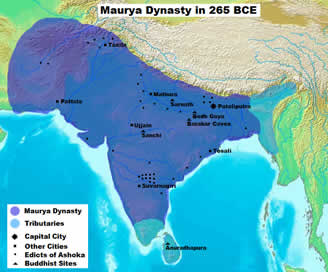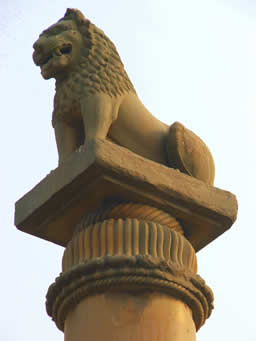If this is a victory, what's a defeat then? Is this justice or injustice?
Conquest of Kalinga
While the early part of Ashoka's reign was apparently quite bloodthirsty, he became a follower of the Buddha's teaching after his conquest of Kalinga on the east coast of India in the present-day state of Orissa. Kalinga was a state that prided itself on its sovereignty and democracy. The pretext for the start of the Kalinga War (265 BC or 263 BC) is uncertain. One of Susima's brothers (Sushima was a prince of Mauryan Empire and half-brother of Asoka. He was in line for his father Bindusara's throne, but was killed by Asoka) might have fled to Kalinga and found official refuge there. Kalinga put up a stiff resistance, but they were no match for Ashoka's brutal strength.
The whole of Kalinga was plundered and destroyed. It is said that in the aftermath of the Battle of Kalinga the Daya River running next to the battle field turned red with the blood of the slain. Nearly 1,00,000 men were killed and another 1,50,000 people driven from the land in the terrible violence that Ashoka, unleashed when he invaded the neighboring kingdom of Kalinga. Thousands of men and women were deported. The whole of Kalinga was plundered and destroyed.
 Maurya Empire at the age of Ashoka. The empire stretched from Iran to Bangladesh/Assam and from Central Asia (Afghanistan) to South India.
Maurya Empire at the age of Ashoka. The empire stretched from Iran to Bangladesh/Assam and from Central Asia (Afghanistan) to South India.
Transformation & Buddhist conversion
One day after the war was over, Ashoka ventured out to roam the city and all he could see were burnt houses and scattered corpses. Ashoka had seen the bloodshed with his own eyes. He felt that he was the cause of the destruction. This sight made him sick and he cried the famous monologue:
“What have I done? If this is a victory, what's a defeat then? Is this a victory or a defeat? Is this justice or injustice? Is it gallantry or a rout? Is it valor to kill innocent children and women? Do I do it to widen the empire and for prosperity or to destroy the other's kingdom and splendor? One has lost her husband, someone else a father, someone a child, someone an unborn infant.... What's this debris of the corpses? Are these marks of victory or defeat? Are these vultures, crows, eagles the messengers of death or evil?”
Word-of-mouth stories tells that after the war was over and Ashoka saw the destruction he had caused, a woman approached him and said, "Your actions have taken from me my father, husband, and son. Now what will I have left to live for?". Moved by these words, it is said, that he accepted/adopted Buddhism. He vowed to never take life again and became one of the most just ruler India has ever seen.
 Asokan pillar at Vaishali, Bihar, India
Asokan pillar at Vaishali, Bihar, India
The Kalinga War prompted Ashoka, already a non-engaged Buddhist, to devote the rest of his life to Ahimsa (non-violence) and to Dhamma-Vijaya (victory through Dhamma). Ashoka ended the military expansion of the empire, and led the empire through more than 40 years of relative peace, harmony and prosperity. He used his position to propagate the relatively new religion to new heights, as far as ancient Rome and Egypt. He made Buddhism his state religion around 260 BC, and propagated it and preached it within his domain and worldwide from about 250 BC. Emperor Ashoka undoubtedly has to be credited with the first serious attempt to develop a Buddhist policy.
During the remaining portion of Ashoka's reign, he pursued an official policy of nonviolence (ahimsa). Even the unnecessary slaughter or mutilation of people was immediately abolished. Everyone became protected by the king's law against sport hunting and branding. He treated his subjects as equals regardless of their religion, politics and caste. The kingdoms surrounding his, so easily overthrown, were instead made to be well-respected allies.
Ashoka defined the main principles of dharma (dhamma) as nonviolence, tolerance of all sects and opinions, obedience to parents, respect for the Brahmans and other religious teachers and priests, liberality towards friends, humane treatment of servants, and generosity towards all.